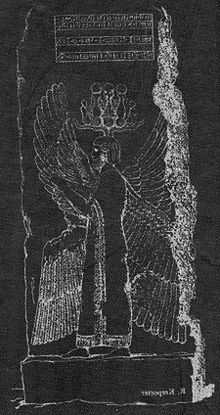Cyrus (name)

Cyrus /ˈsaɪərəs/ is the given name of a number of Persian kings. Most notably it refers to Cyrus the Great. Cyrus is also the name of Cyrus I of Anshan (ca. 650 BC), King of Persia the grandfather of Cyrus the Great; and Cyrus the Younger (died 401 BC), brother to the Persian King Artaxerxes II of Persia.
Cyrus, as a word in English, is the Latinized form of the Greek Κῦρος, Kȳros, from Old Persian 𐎤𐎢𐎽𐎢𐏁 Kūruš.[1] According to the inscriptions the name is reflected in Elamite Kuraš, Babylonian Ku(r)-raš/-ra-áš and Imperial Aramaic kwrš. The modern Persian form of the name is Kourosh.
The etymology of Cyrus has been and continues to be a topic of discussion amongst historians, linguists, and scholars of Iranology. The Old Persian name "kuruš" has been interpreted in various forms from "the sun", "like sun", "young", "hero" to "humiliator of the enemy in verbal contest" and the Elamite "kuraš" has been translated as one "who bestows care".
The name has appeared on many monuments and inscriptions in Old Persian.[2] There is also the record of a small inscription in Morghab (southwestern Iran) on which there is the sentence (adam kūruš xšāyaƟiya haxāmanišiya) in Old Persian meaning (I am Cyrus the Achaemenian King).[3] After a questionable[4] proposal by the German linguist F. H. Weissbach that Darius the Great was the first to inscribe in Persian, it had previously been concluded by some scholars that the inscription in Morghab refers to Cyrus the Younger. This proposal was the result of a false interpretation of a passage in paragraph 70 of Behistun inscription by Darius the Great.[5] Based on many arguments,[6] the accepted theory among modern scholars is that the inscription does belong to Cyrus the Great.[7]
There are interpretations of name of Cyrus by classical authors identifying with or referring to the Persian word for “sun”. The Historian Plutarch (46 - 120) states that "the sun, which, in the Persian language, is called Cyrus"[8] Also the Physician Ctesias who served in the court of the Persian king Artaxerxes II of Persia writes in his book Persica as summarized by Photios that the name Cyrus is from Persian word "Khur" (the sun).[9] These are however not accepted by modern scholars.[1]
Regarding the etymology of Old Persian kuruš, linguists have proposed various etymologies based on Iranian languages as well as non-Indo-European ones.[10] According to Tavernier, the name kuraš, attested in Elamite texts, is likely "the original form" as there is no Elamite or Babylonian spelling ku-ru-uš in the transcriptions of Old Persian ku-u-r(u)-u-š. That is, according to Tavernier, kuraš is an Elamite name and means "to bestow care".[10] Others, such as Schmitt, Hoffmann maintain that the Persian Kuruš, which according to Skalmowsky, may be connected to (or a borrowing from) the IE Kúru- from Old Indic can give an etymology of the Elamite kuraš.[1][10] In this regard the Old Persian kuruš is considered with the following etymologies: One proposal is discussed by the linguist Janos Harmatta that refers to the common Iranian root "kur-" (be born) of many words in Old, middle, and new Iranian languages (e.g. Kurdish). Accordingly the name Kūruš means "young, youth,..".[11] Other Iranian etymologies have been proposed. The Indian proposal of Skalmowsky goes down to "to do, accomplish". Another theory is the suggestion of Karl Hoffmann that kuruš goes down to a -ru derivation from the IE root *(s)kau meaning "to humiliate"[10] and accordingly "kuruš" (hence "Cyrus") means "humiliator (of the enemy in verbal contest)".[1]
See also
- Cyrus the Great
- Kourosh (name), modern Persian form
- Kira (given name), female form
- Cyrus Cylinder
- Cyrus in the Judeo-Christian tradition and Cyrus the Great in the Quran
- Cyrus Vance
Notes
- ↑ 1.0 1.1 1.2 1.3 (Schmitt 1996a)
- ↑ (Gershevitch 1985, pp. 392–5)
- ↑ (Tolman 1908, p. 55)
- ↑ (Tolam 1908, p. 82)
- ↑ (Gershevitch 1985, p. 395)
- ↑ (Ghirshman 1965, p. 246)
- ↑ (Schmitt 1996b)
- ↑ Plutarch, Artoxerxes in (Parallel lives).
- ↑ Epitome of Ctesias' Persica 52.
- ↑ 10.0 10.1 10.2 10.3 (Tavernier 2007, p. 528)
- ↑ (Harmatta 1971, pp. 5–6)
References
- Ghirshman, R. (1965), "A propos de l'ecriture cuneiforme vieux-perse", JNES 24 (3): 244–250, doi:10.1086/371818
- Schmitt, Rüdiger (1996a), "Cyrus i. The Name", in Yarshater, Ehsan, Encyclopaedia Iranica 6, London: Routledge & Kegan Paul, pp. 515–16
- Schmitt, Rüdiger (1996b), "Cyrus vi. Cyrus the Younger", in Yarshater, Ehsan, Encyclopaedia Iranica 6, London: Routledge & Kegan Paul, p. 518
- Tavernier, Jan (2007), Iranica in the Achaemenid Period (ca. 550-330 B.C.): Linguistic Study of Old Iranian Proper Names and Loanwords, Attested in Non-Iranian Texts, Peeters Publishers, ISBN 90-429-1833-0
- Tolman, Herbert Cushing (1908), Ancient Persian Lexicon, American Book Company, ISBN 0-7905-2613-1
- Gershevitch, Ilya (1985), The Cambridge History of Iran Vol. 2: The Median and Achaemenian periods, Cambridge University Press, ISBN 978-0-521-20091-2
- Harmatta, János (1971), "The Rise of the Old Persian Empire — Cyrus the Great", Acta Antiqua Academiae Scientiarum Hungaricae 19: 1–15